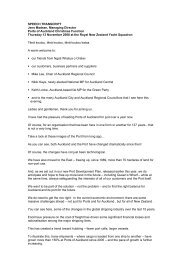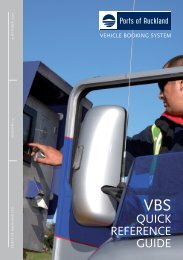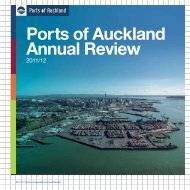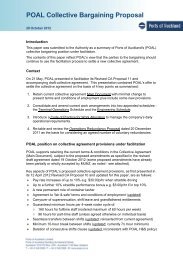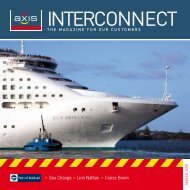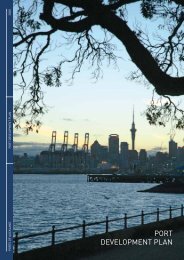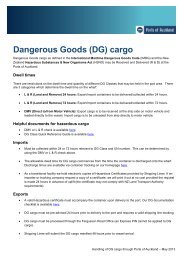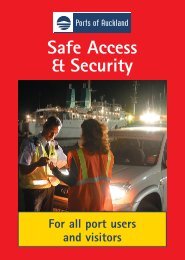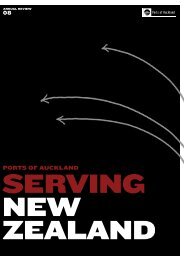ONE - Ports of Auckland
ONE - Ports of Auckland
ONE - Ports of Auckland
Create successful ePaper yourself
Turn your PDF publications into a flip-book with our unique Google optimized e-Paper software.
PORT-CENTRICITY<br />
Port-centric logistics is the current buzz in<br />
Europe according to Fairplay Magazine which<br />
reports on an inaugural conference <strong>of</strong> supply<br />
chain partners in Manchester mid year, that<br />
was inspired by this concept. It seems that<br />
the evocatively named port-centric logistics is<br />
about reducing road miles to lower costs and<br />
emissions. In Europe’s ‘carbon-constrained’<br />
society, large retailers eg Tesco, are embracing<br />
port-centric logistics by setting up distribution<br />
points at the ports and delivering from<br />
these to shops and regional hubs rather<br />
than trucking containers from the ports to<br />
the central distribution hubs and on then to<br />
regional hubs and retail outlets.<br />
LIFE WITHOUT THE<br />
CONFERENCE<br />
After a transition period, the door closed<br />
forever this year on the shipping liner<br />
Conference system in Europe. Formed<br />
originally to negate price wars, the Conference<br />
system’s demise is likely to bring many<br />
changes including common rating by carriers<br />
for a range <strong>of</strong> ports. Under the Conference,<br />
carriers would quote shippers the same<br />
price for carrying a box from eg, USA to<br />
three European ports – even though their<br />
costs for each port may have been different.<br />
Shippers benefited from this aspect <strong>of</strong> the<br />
System. Hong Kong publication, The Container<br />
Shipping Manager (CSM), forecasts that this<br />
is one aspect <strong>of</strong> the System that is ‘destined<br />
for oblivion’. ‘Powerful computer systems are<br />
now giving carriers the ability to measure<br />
the actual costs for each port to port transit<br />
and shipping lines will increasingly begin to<br />
charge different prices for different port pairs<br />
according to how much it costs them’ the<br />
publication warns.<br />
CONTAINER SHORTAGE<br />
both Fairplay and CSM over the last month or<br />
two, have addressed the issue <strong>of</strong> the ‘acute’<br />
container shortage. Fairplay quotes dynamar,<br />
the dutch market research company, which<br />
estimates that the fall in new container<br />
production and equipment scrapping in 2009,<br />
prompted an undersupply <strong>of</strong> just over 2M TEU,<br />
assuming that all container vessels return to<br />
trading. This says dynamar, should be partly<br />
<strong>of</strong>fset by global box production <strong>of</strong> 1.5–2M TEU<br />
in 2010 – ‘which still leaves a gap <strong>of</strong> hundreds<br />
<strong>of</strong> thousands <strong>of</strong> TEU’ concludes Fairplay.<br />
PRECISE PLANNING<br />
NEEDED<br />
The shortage <strong>of</strong> equipment is having<br />
widespread repercussions. In August, The NZ<br />
Shipping Gazette reported Maersk’s decision<br />
to cease accepting dry cargo from Southern<br />
Africa to Oceania ‘due to an urgent need to<br />
reposition containers’. Attributing the decision<br />
to the worldwide shortage <strong>of</strong> dry containers,<br />
Maersk’s NZ Country Manager Julian bevis<br />
said the shortage was forcing the Line to<br />
be more selective: “we get more out <strong>of</strong> it if<br />
the boxes go to Asia” he commented. Such<br />
decisions are putting pressure on shippers to<br />
be well informed when doing their seafreight<br />
planning according to Fairplay which warns<br />
that shipping lines are calling for better volume<br />
forecasts from their shipper customers,<br />
coupled with precise routeing information’. The<br />
carriers say shippers could get better capacity<br />
and equipment utilisation if they transferred<br />
transport data more rapidly down the chain.<br />
what is clear is that in recent time, shippers<br />
have seen some reduction in the flexibility<br />
previously allowed them by the shipping lines<br />
in their volume contracts. Shippers it seems,<br />
will also have to work smarter on contract<br />
negotiations. Freight Forwarders (who claim a<br />
faster growing market share than ship owners<br />
these days) are ‘scrambling to add special<br />
equipment provisions to their contracts in order<br />
to secure the equipment they need’ according<br />
to Fairplay.<br />
CAUTIOUS OPTIMISM<br />
Media reports indicate that a cautious optimism<br />
is creeping back into the industry after four<br />
months <strong>of</strong> steadily climbing container volumes<br />
and freight rates. This positivity is supported<br />
by very reasonable 1st quarter 2010 pr<strong>of</strong>its<br />
for several carriers that have been pleased to<br />
reverse last year’s losses. It would seem that the<br />
front line beneficiaries in this change <strong>of</strong> fortune<br />
are the owner-operators. Struggling with sharp<br />
declines in the time charter market, non-owneroperators<br />
have not fared so well analysts say.<br />
SLOW STEAMING<br />
The ‘popular cost-cutter’ slow steaming is<br />
rapidly catching on with some carriers slowing<br />
to 12 knots according to CSM. Maersk is believed<br />
to have saved over USd$102M on reduced fuel<br />
consumption since introducing slow steaming.<br />
The Line claims that the cost benefits are clear<br />
with speed reduced by 20% enabling fuel<br />
consumption reduction <strong>of</strong> 40%. Maersk says<br />
slow steaming is here to stay.<br />
13




